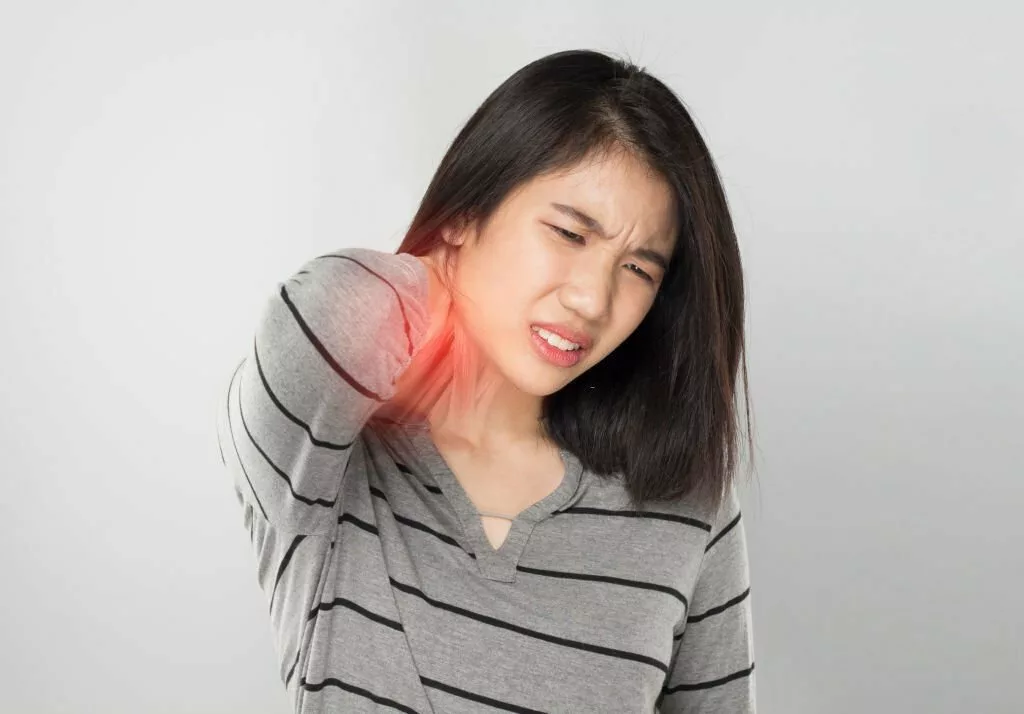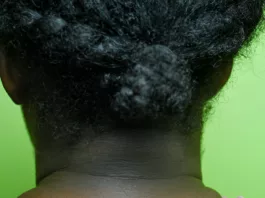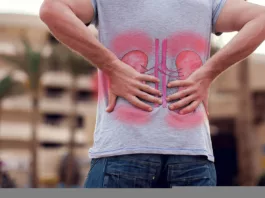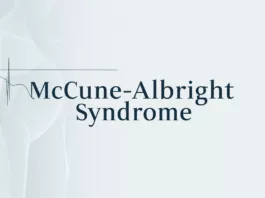What is a Neck Sprain?
A neck sprain, also called a cervical sprain, is an injury that affects the ligaments in your neck. Ligaments are the tough, fibrous tissues that connect bones to one another. Neck sprains typically occur when the neck is bent or twisted beyond its normal range of motion, leading to overstretching or tearing of the ligaments. Common causes include sudden movements, such as whiplash from a car accident, falls, sports injuries, or awkward sleeping positions. Symptoms of a neck sprain may include pain, stiffness, reduced range of motion, muscle spasms, and sometimes headaches or pain radiating to the shoulders and upper back. While they are not usually considered medical emergencies, they can result in significant pain. These injuries can be quite debilitating.1Bragg KJ, Varacallo M. Cervical Sprain. [Updated 2023 Aug 14]. In: StatPearls [Internet]. Treasure Island (FL): StatPearls Publishing; 2024 Jan-. Available from: https://www.ncbi.nlm.nih.gov/books/NBK541016/
Causes of Neck sprains
You may suffer from neck sprains due to injuries to your neck muscles. These injuries can be due to many reasons, such as:
- Trauma such as an MVH (motor vehicle accident) or Contact sports. These can lead to a whiplash injury.
- Carrying a heavy object on one side of the body.
- Lifting heavy weights, especially without proper training or poor posture.
- Extreme neck movements, such as bending back or forward, especially when done suddenly.
- Spending time in uncomfortable postures or positions.
- Poor sleeping positions.
What is a Whiplash Injury?
It is a type of neck sprain. Whiplash leads to various disorders such as neck pain, stiffness, numbness, etc. It can happen in any age group but has more severe effects on women and the elderly. Whiplash injury occurs when inertia causes your head, neck, and body to move at different speeds.2Evans RW. Persistent post-traumatic headache, postconcussion syndrome, and whiplash injuries: the evidence for a non-traumatic basis with an historical review. Headache. 2010 Apr;50(4):716-24.
Whiplash injuries are estimated to affect 0.3% of the population in the U.S. annually, most commonly resulting from motor vehicle accidents but also occurring during sports injuries and falls.3Anderson C, Yeung E, Toong T, Tong T, Reed N. A narrative review on cervical interventions in adults with chronic whiplash-associated disorder. BMJ Open Sport Exerc Med. 2018;4(1):e000299. Car collisions or injuries in contact sports can generate sufficient inertia to cause whiplash injury. This causes your neck to compress or extend too quickly or in ways that push your spine’s muscles, ligaments, and bones beyond their limits.4 Yadla, S., Ratliff, J. K., & Harrop, J. S. (2008). Whiplash: diagnosis, treatment, and associated injuries. Current reviews in musculoskeletal medicine, 1(1), 65–68. https://doi.org/10.1007/s12178-007-9008-x

Risk Factors of Neck Sprains
Certain habits or past medical events can make neck sprains more likely. These include:
- Poor posture
- Poor lifting techniques
- Improper sleeping techniques
- Repetitive strain injuries
- Previous neck surgeries
Symptoms of Neck sprains
Most episodes of acute pain involving the neck muscles resolve spontaneously. Cases that don’t resolve present with neck pain and decreased range of motion. Neck pain that is aching or sharp and may worsen with movement is a hallmark symptom of neck sprain. The neck may also feel stiff or difficult to move. You may have other signs, including:
- Pain radiating to the upper limb
- Visual disturbances
- Psychological distress.
- Headaches originating from the back of your head
- Weakness or tingling sensations (usually a sign of nerve damage).
How are Neck Sprains Diagnosed?
Doctors diagnose neck sprains during clinical visits by performing a physical exam, taking your medical history, and ordering diagnostic tests. One common test they may use is the Spurling test, which is an aggressive pain progression test.5Jones SJ, Miller JMM. Spurling Test. [Updated 2023 Aug 8]. In: StatPearls [Internet]. Treasure Island (FL): StatPearls Publishing; 2023 Jan-. Available from: https://www.ncbi.nlm.nih.gov/books/NBK493152/ The doctor will first inform you of each step. The test involves combining cervical spine extension and tilt toward the affected limb while applying pressure downward on your head. The purpose of this test is to rule out cervical nerve root irritation. Additionally, your physician may also assess your range of motion.
Lastly, X-rays, CTs, or MRIs can confirm the diagnosis. Neck sprains are not visible on X-rays, which can rule out other more severe conditions, like spinal fractures, that present with similar symptoms.
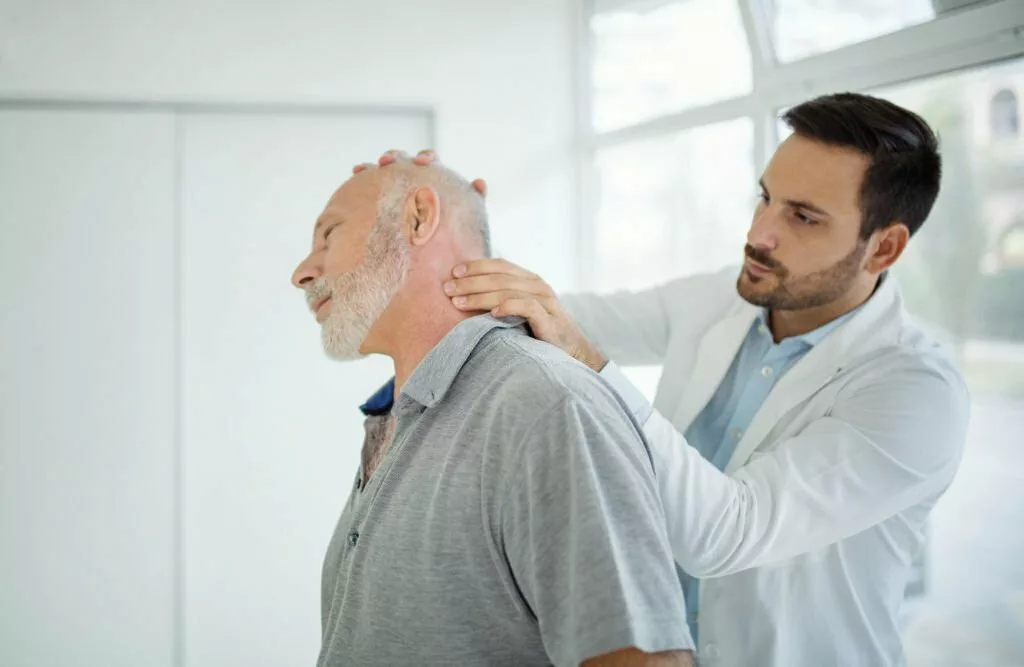
How are Neck Sprains Treated?
Neck injuries heal gradually with time. Your medical professional, after diagnosis, may suggest treatments to improve your range of motion and reduce inflammation or pain. These include6Ritchie C, Hollingworth SA, Warren J, Sterling M. Medicine use during acute and chronic postinjury periods in whiplash-injured individuals. Pain. 2019 Apr;160(4):844-851.
Physiotherapy:
This can improve neck strength and flexibility. Physiotherapy may include range of motion exercises, neck exercises, massages, etc.
OTC Painkillers:
These can relieve pain, tenderness, and inflammation. Some examples of OTC painkillers include Ibuprofen and Acetaminophen.
Injectable Muscle Relaxants:
These can relax specific neck muscles and relieve stiffness, pain, and discomfort caused by strains, sprains, or muscle injuries. However, muscle relaxants are not a substitute for rest, exercise, or physical therapy. These additional measures are still crucial for your recovery.
Intramuscular lidocaine Injections:
Lidocaine7Peloso P, Gross A, Haines T, Trinh K, Goldsmith CH, Burnie S., Cervical Overview Group. Medicinal and injection therapies for mechanical neck disorders. Cochrane Database Syst Rev. 2007 Jul 18;(3): CD000319. is a rapidly acting local anesthetic. It is effective in treating various neuropathic pain conditions. Hence, it can also be used to manage both acute and chronic neck pain.
Other treatment measures that doctors may recommend for neck sprains include:
- Applying heat can relieve muscle cramps and discomfort. However, don’t use heat on the skin for more than 30 minutes.
- You can also apply ice packs to the affected region. Wrap the ice in towels or clothes to avoid direct contact with the skin. Ice packs are most effective when applied several times for 15-30 minutes in the first few days following injury.
- You can use pain-relieving medication like Ibuprofen and Acetaminophen.
- Neck braces or supportive collars to promote healing.
If you have been in a vehicular crash, emergency medical personnel may put a C-Collar on you to immobilize your neck. This is to prevent the worsening of the injury and to provide support.
How long do Neck Sprains take to Heal?
Recovery time will depend on a range of factors. More severe injuries take longer to heal. However, most people who receive proper treatment and rest will recover in four to six weeks.8 Neck Sprains and Strains – OrthoInfo – AAOS. (n.d.). Retrieved July 19, 2023, from www.orthoinfo.org website: https://orthoinfo.aaos.org/en/diseases–conditions/neck-sprain/#:~:text=Recovery But more severe injuries may take four months to heal. If you are an athlete, you won’t be allowed to return to your sport without physician clearance. This is because you may unintentionally worsen your condition during strenuous physical activity.

How to Prevent Neck Sprain?
Certain lifestyle changes can be made to decrease the likelihood of neck sprains. These include lifestyle changes such as:
- Regular exercise is essential for strengthening neck muscles. It can also help improve posture and alleviate stress, which contributes to muscle stiffness.9Durall C. J. (2012). Therapeutic exercise for athletes with nonspecific neck pain: a current concepts review. Sports health, 4(4), 293–301. https://doi.org/10.1177/1941738112446138
- Avoid lifting heavy loads.
- Wear seat belts and outfit your vehicle with proper safety procedures.
- Using feather pillows or memory foam pillows when sleeping. These pillows easily conform to the shape of your neck and head. However, feather pillows tend to lose shape over time and should be replaced every one or two years.
- Avoid using pillows that are too stiff or deep. These pillows can strain your neck muscles overnight.
- Changing sleeping postures, e.g., stomach sleepers can try to sleep on their side or back.
Difference between Neck Strains & Neck Sprains
Neck strains (cervical strains) involve the muscles or tendons of the neck and usually happen when the neck is hyperextended. They are categorized based on pain and muscle injury severity. Grade 1 strains have mild pain, while Grade 3 strains indicate torn neck muscles, causing severe pain and muscle weakness. If left untreated, Grade 2 or Grade 3 strains can lead to chronic pain, headaches, and disability.
On the other hand, neck sprains are injuries to the neck’s ligaments and occur when the neck is bent or rotated abnormally. These injuries also cause severe pain. Both neck strains and neck sprains have similar symptoms.
How do you get a Neck Sprain from Sleeping?
Neck sprains can result from poor sleeping positions, such as sleeping on your stomach. They may also result from using a pillow that inadequately supports your neck. Other rare causes include tossing and turning in your sleep (sudden movements such as those that may arise from nightmares) or previous injuries.
Conclusion
In conclusion, neck sprains are caused by abnormal neck bending or rotation, leading to ligament injuries. They result in severe pain and limited movement but are usually not emergencies. Trauma, poor posture, improper lifting, and repetitive strain can contribute to their development. The treatment includes physiotherapy, pain relievers, muscle relaxants, and heat/ice packs. Most people with neck sprains will recover in 4-6 weeks with proper care. Preventive measures like exercise and proper lifting techniques can reduce the risk of developing a neck sprain. Seek medical advice for effective treatment and timely intervention.
Refrences
- 1Bragg KJ, Varacallo M. Cervical Sprain. [Updated 2023 Aug 14]. In: StatPearls [Internet]. Treasure Island (FL): StatPearls Publishing; 2024 Jan-. Available from: https://www.ncbi.nlm.nih.gov/books/NBK541016/
- 2Evans RW. Persistent post-traumatic headache, postconcussion syndrome, and whiplash injuries: the evidence for a non-traumatic basis with an historical review. Headache. 2010 Apr;50(4):716-24.
- 3Anderson C, Yeung E, Toong T, Tong T, Reed N. A narrative review on cervical interventions in adults with chronic whiplash-associated disorder. BMJ Open Sport Exerc Med. 2018;4(1):e000299.
- 4Yadla, S., Ratliff, J. K., & Harrop, J. S. (2008). Whiplash: diagnosis, treatment, and associated injuries. Current reviews in musculoskeletal medicine, 1(1), 65–68. https://doi.org/10.1007/s12178-007-9008-x
- 5Jones SJ, Miller JMM. Spurling Test. [Updated 2023 Aug 8]. In: StatPearls [Internet]. Treasure Island (FL): StatPearls Publishing; 2023 Jan-. Available from: https://www.ncbi.nlm.nih.gov/books/NBK493152/
- 6Ritchie C, Hollingworth SA, Warren J, Sterling M. Medicine use during acute and chronic postinjury periods in whiplash-injured individuals. Pain. 2019 Apr;160(4):844-851.
- 7Peloso P, Gross A, Haines T, Trinh K, Goldsmith CH, Burnie S., Cervical Overview Group. Medicinal and injection therapies for mechanical neck disorders. Cochrane Database Syst Rev. 2007 Jul 18;(3): CD000319.
- 8Neck Sprains and Strains – OrthoInfo – AAOS. (n.d.). Retrieved July 19, 2023, from www.orthoinfo.org website: https://orthoinfo.aaos.org/en/diseases–conditions/neck-sprain/#:~:text=Recovery
- 9Durall C. J. (2012). Therapeutic exercise for athletes with nonspecific neck pain: a current concepts review. Sports health, 4(4), 293–301. https://doi.org/10.1177/1941738112446138

